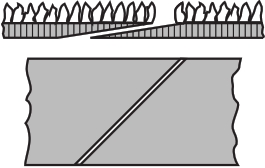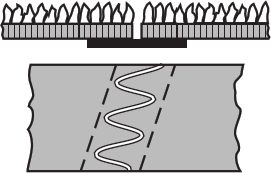

The sanding belt is connected together by a joint, forming a ring belt, suitable for various belt grinding machines.
The most critical part is that joint, because it is an artificial intersection and must be done in the most careful and efficient way, ensuring high resistance and promoting smooth motion without vibration.
Type of joint
There are two main distinguishable joints: overlap and butt.
Overlapping
This type of joint was most common during the first few years of industrial use of the belt. Although it is still in use today, the overlaid back base that must be dealt with can cause all kinds of inconvenience during rolling.
This joint method is most suitable for paper bases because of its very small thickness and because it does not have the wire weaving that occurs in textile supports, it can be mitered without the risk of compromising its resistance. In addition, the paper itself has excellent bonding ability, forming a stable and strong bonding.
This overlap joint is also the main reason for the arrowhead printed on the back of the flexible abrasive indicating the direction of movement in which the sand belt must be mounted on the machine.
Because, if the belt is used in the opposite direction, the overlap of the abrasive portion may be elevated by the constant friction it exerts on the workpiece to be polished, thus breaking the joint and with it the belt.
The fabrication of overlapping joints requires extensive experience and expertise, as the flexible nature of the bracket does not help to make its behavior stable during the bewel process and can be easily automated. If done precisely, overlapping joints are likely to be most effective.

Butt
Butt splicing is done by connecting the ends of the sanding belt face to face, without overlapping, and securing the connection with tape specially designed for this purpose, which sticks to the backs of the ends and joins them very effectively.
This type of joint and its variants are the most widely used today because it does not require such a precise miter operation, its automation is simple and versatile, and the connecting tape or film has very low thickness and strong tensile strength.
Another great advantage is its symmetry. There is no overlap in this oriented structure, so the belt can cycle the joint dip Angle in both directions without problem.

Angle of joint
Whether overlapping or butt splicing, joints rarely form right angles. If this is the case, the joint area will strike the workpiece uniformly across the entire workpiece surface, resulting in continuous strikes that produce noise and high vibration, which can rapidly impair the strength of the joint.
In addition to providing a larger anchoring surface, which will enhance its drag, the slight Angle will always help the belt cycle smoothly, avoiding premature wear the smaller the Angle relative to the direction of movement of the sand belt, or the further away it is from the right Angle, the better its drag and dynamic performance.
However, very small angles can create very sharp edges at the ends and become weak areas that are very easy to break or separate, especially when using small pulleys or curvatures.
The most common Angle is usually 45° to 70°
Special joint
Most applications can fit perfectly with the above criteria, whether overlapping or butt splicing, with dimensional tolerances low enough to allow traditional sanding processes to be used without marks or scratches, and with high enough tensile strength.
However, there are some particularly demanding applications where special joints must be used for high resistance flexibility or smoothness.
There are many types of tape used to make joints, and their width, thickness, resistance and flexibility may be large or small, depending on the resistance of the process to the sensitivity of the trace support or the size of the abrasive particles used.
These adhesive strips or films can resist working stresses greater than 60Kg/cm. If greater resistance is required, special tapes of greater thickness and width can be used, or other thinner strips More flexible tape for very flexible straps or very fine grits.
---EDITOR:Doris Hu
---POST: Doris Hu
Semiconductor Industry Solutions
PCD & PCBN Tools Grinding Industry
Diamond Cutting Bruting Polishing
Add: No.171 Zhongyuan Rd, Zhongyuan District, Zhengzhou, 450001, Henan, China
Tel: +86-371-86545906
Phone / Whats App: +86 18339903057
E-mail: [email protected]



